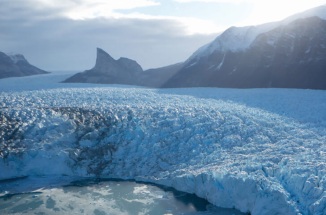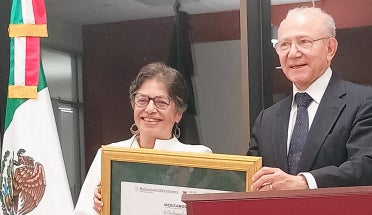
Jackson School Expedition Explores Greenland's Glaciers
- Apr 10, 2023
According to the National Snow and Ice Data Center, the 2022 melt season in Greenland (between April 1 and Oct. 31) saw the 19th-highest melt rate in a 43-year satellite record. The annual net loss of ice worldwide is increasing faster than the ice sheets are regenerating and advancing.
But in anecdotal observation, the glaciers’ edges in three of Greenland’s fjords vary in their melting behavior, and that lack of uniformity poses questions for scientists. A team from The University of Texas at Austin’s Jackson School of Geosciences proposes that finding more accurate answers requires a team of experts and a submersible robot to explore the uncharted territory beneath the ice.
The university’s only faculty glaciologist, Ginny Catania, first submitted the research proposal to the W.M. Keck Foundation with colleague Tim Bartholomaus from the University of Idaho in 2017. The proposal aimed to secure $1.5 million in funding for the expedition, including the acquisition of the submersible remotely operated vehicle, plus the ship, its crew and the field technicians to operate equipment. In December 2022, Catania and Bartholomaus were awarded the Keck funding.
Catania is part of a team of experts at UT Austin, including Sean Gulick, Benjamin Keisling, John Goff, Marcy Davis and Dan Duncan, who study morainal banks beneath the glaciers to better understand how sediment may stabilize and insulate the glaciers.
“The climate system (the ocean and the atmosphere) matters, obviously, to the ice sheets, but the topography, the geometry … has a first-order effect on how the ice is going to respond to climate,” Catania says. “You can think about the climate pushing an ice sheet into a new state, but the topography controls how much change happens.”
In late summer 2024, the team will travel on a ship called the RV Celtic Explorer with a cohort of engineers and technicians, who will operate a robot called the Nereid Under Ice (NUI), designed and engineered at the Woods Hole Oceanographic Institution in Massachusetts. The team will collect data 24 hours a day in shifts.
Being awarded access to the NUI puts UT researchers at the cutting edge of global discussions on climate change and suggests more accurate predictions on the timeline for sea level rise.
“Greenland can give us 23 feet of sea level rise; Antarctica can give us 197 feet of sea level rise. So it’s a large problem,” Catania says. “And we’re seeing that there’s this big spread from Greenland alone, so Greenland is probably going to contribute the most.”
Read more about the expedition in campus magazine Texas Connect.



